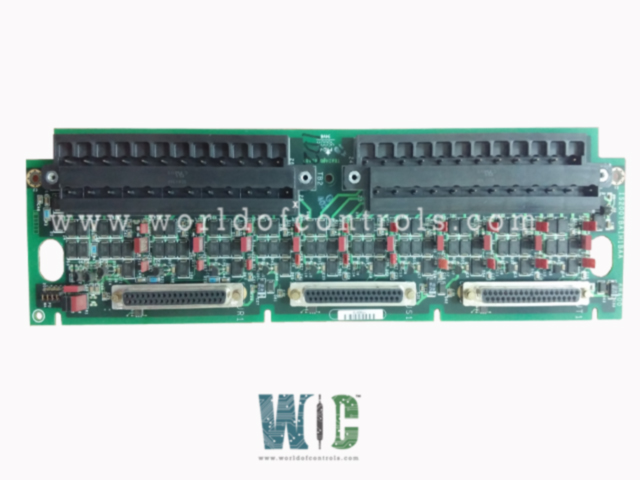SPECIFICATIONS
Part No.: IS200TBAIH1BCC
Manufacturer: General Electric
Country of Manufacture: United States of America (USA)
Temperature: -30 to 65oC
Number of channels: 12
Outputs: 24 V
Temperature: -30 to 65 oC
Size: 10.16 cm wide x 33.02 cm high
Product Type: Analog Input terminal board
Availability: In Stock
Series: Mark VI
Functional Description
IS200TBAIH1BCC is an analog input terminal board developed by GE. It is part of Mark VI control system. The Analog Input terminal board facilitates the integration of 10 analog inputs and two outputs. These inputs are versatile, catering to two-wire, three-wire, four-wire, or externally powered transmitters. Additionally, the analog outputs can be configured to deliver either 0-20 mA or 0-200 mA current. To ensure reliable performance, both inputs and outputs are equipped with noise suppression circuitry, safeguarding against surge and high-frequency noise disruptions.
Features
- Analog Inputs and Outputs: TBAI supports 10 analog inputs and two outputs, offering versatile compatibility for various types of transmitters. Analog inputs accommodate two-wire, three-wire, four-wire, or externally powered transmitters, ensuring flexibility in signal acquisition. Analog outputs can be configured for 0-20 mA or 0-200 mA current, allowing for precise control and monitoring capabilities.
- Noise Suppression Circuitry: Inputs and outputs are equipped with noise suppression circuitry to safeguard against surge and high-frequency noise disturbances. This feature ensures reliable and accurate signal processing, even in environments prone to electrical interference.
- Connectivity Options: TBAI offers three DC-37 pin connectors for seamless integration with I/O processors. Connections may be simplex via a single connector (JR1) or redundant (TMR) using all three connectors, providing flexibility in system design. Connections can be established through cables or directly to the electronics, accommodating various installation setups and configurations.
- TMR Functionality: In Triple Modular Redundancy (TMR) applications, input signals are fanned out to the three connectors (R, S, and T controls) for redundancy and fault tolerance. TMR outputs function by combining the current from the three connected output drivers, ensuring redundancy and reliability in critical control systems. Total current signal is measured using a shunt on the TBAI and presented to the electronics for regulation to the commanded setpoint, ensuring accurate control even in the event of component failures.
Installation
- Mounting the Terminal Blocks:
- Securely mount the two I/O terminal blocks directly onto the TBAI terminal board.
- Each terminal block should be held down firmly with two screws to ensure stability.
- The terminal blocks feature 24 terminals designed to accept wires up to 12 AWG, providing ample capacity for wiring connections.
- Adjacent to each terminal block, locate the shield terminal attachment point, which facilitates grounding for enhanced signal integrity.
- 2. Wiring Connections:
- Wire the 10 analog inputs and two outputs directly to the respective terminals on the I/O terminal blocks.
- Ensure proper termination of wires according to the specified wire gauge requirements.
- Verify the integrity of wiring connections to prevent signal loss or interference.
- 3. Compatible Analog Input/Output Types:
- The TBAI terminal board accommodates various types of analog inputs and outputs, including:
- Two-wire transmitter
- Three-wire transmitter
- Four-wire transmitter
- Externally powered transmitter
- Voltage inputs (5 V, 10 V dc)
- Analog outputs (0-20 mA, 0-200 mA)
- Ensure compatibility between the connected transmitters/sensors and the terminal board to achieve optimal performance.
- 4. Shielding Considerations:
- Take into account the shielding requirements for analog signals, especially in environments prone to electromagnetic interference.
- Utilize the shield terminal attachment points adjacent to the terminal blocks for proper grounding to minimize signal noise and ensure signal integrity.
- By following these installation procedures, you can effectively set up the Analog Input terminal board (TBAI) and establish reliable connections for analog signal processing in your control system. Regular inspections and maintenance are recommended to uphold system performance and integrity.
The WOC team is always available to help you with your Mark VI requirements. For more information, please contact WOC.
Frequently Asked Questions
What is IS200TBAIH1BCC?
It is an analog input terminal board developed by GE under the Mark VI series.
How many analog inputs does the terminal board support?
The analog input terminal board supports a total of 10 analog inputs.
What types of transmitters are compatible with the analog inputs?
The analog inputs accommodate a variety of transmitters, including two-wire, three-wire, four-wire, or externally powered transmitters.
Can you specify the available options for analog outputs?
Yes, the analog outputs on the terminal board can be configured for either 0-20 mA or 0-200 mA current.
